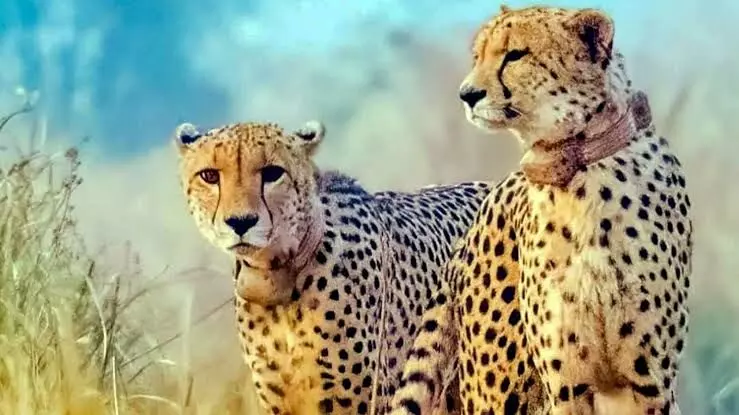2 years of Project Cheetah: India awaits Kenya's approval for new batch
The cheetah conservation breeding centre being developed in a 500-hectare enclosure can accommodate 16 cheetahs
By Newsmeter Network
Cheetahs
New Delhi: The Memorandum of Understanding (MoU) process to bring a new batch of cheetahs from Kenya is in progress, with India having finalised its part and awaiting approval from the African country, a senior official has said.
Cheetahs for the breeding centre being built in Gujarat's Bunni grasslands will also be brought from Kenya, SP Yadav, the director general of the International Big Cat Alliance, told PTI editors during a recent interaction here.
As part of the first-ever intercontinental translocation of the big cats, 20 cheetahs have been brought to the Kuno National Park in Madhya Pradesh so far -- eight from Namibia in September 2022 and 12 from South Africa in February 2023.
Since they arrived in India, eight adult cheetahs -- three females and five males -- have died.
Seventeen cubs have been born in India, with 12 surviving, bringing the total number of cheetahs, including cubs, in Kuno to 24. Currently, all are in enclosures. The grand initiative completes two years on September 17.
The 'Action Plan for Reintroduction of Cheetah in India' talks about bringing around 12-14 cheetahs each year from South Africa, Namibia and other African countries for five years to establish a founder stock.
"The MoU process is in progress. India has finalised its part, and the Kenyan government needs to approve it. After that, both governments will sign the MoU," Yadav, who is the adviser to the Centre's Cheetah Project Steering Committee, said.
"Discussions are ongoing with South Africa. It has already identified 12 to 16 surplus cheetahs. They must either give them to another country or euthanise them. That is the current situation," Yadav added.
In South Africa, animals are kept in sanctuaries based on their carrying capacities. If the population exceeds this capacity, they either export the animals or euthanise them, as they cannot sustain an overpopulation, he explained.
Yadav said cheetahs for the conservation breeding centre being established in Bunni will also be brought from Kenya and that "winter is the ideal time to bring them".
The cheetah conservation breeding centre being developed in a 500-hectare enclosure can accommodate 16 cheetahs, officials have said.
Yadav also dismissed reports suggesting that a Namibian cheetah named Pawan died from poisoning last month. He clarified that there were no signs of poisoning such as saliva oozing from the mouth or liquid seeping from the nose.
"There was no such thing. It is purely speculation," he said.
Asked if cheetahs can drown, he said that it had rained heavily that night and there are nallahs (streams) with boulders and rocks.
"We do not know what happened, but the symptoms suggest that the cheetah died from drowning. There was no other reason. There were no marks on the body. Two doctors conducted the post-mortem and confirmed drowning. There was water in the lungs. It was unfortunate," Yadav added.
Asked about the low prey base in the Kuno National Park and the Gandhi Sagar Wildlife Sanctuary, he said, "The number of cheetahs in the wild will depend solely on the prey population. We will not release more cheetahs if the prey population cannot support them. That is within our control."
Yadav said that the staff at Kuno will administer prophylactic medicine to the cheetahs in the wild through tranquilisers. If they are unsuccessful, "there is no option but to recapture the animals", he said.
Prophylactic medicines are given to prevent infection.
Due to differences in circadian rhythms between the Northern and Southern Hemispheres, some cheetahs developed thick winter coats during the Indian summer and monsoon last year, in anticipation of the African winter (June to September).
Three of these cheetahs -- a Namibian female and two South African males -- died after wounds beneath their winter coats, on their backs and necks, became infested with maggots and led to blood infections.
Asked about the secrecy associated with Project Cheetah, Yadav said that the perception of secrecy is misleading.
"Cheetah introduction has gained unprecedented media attention -- more than any other animal conservation effort before.
"No country, not even developed ones, has dared to undertake an experiment of this kind. If you look at the Western media, it is hard for them to believe that India can accomplish this," he said.
On the progress of Project Cheetah, Yadav said when South Africa lost its entire cheetah population, they imported the animal from Namibia, and it took them 20 years to establish a viable population.
"In India, we lost all the tigers in Sariska Tiger Reserve in Rajasthan in 2005. It took nearly 15 years to re-establish a stable population there.
"It takes time; it is not instant coffee," he said.
Inputs from PTI